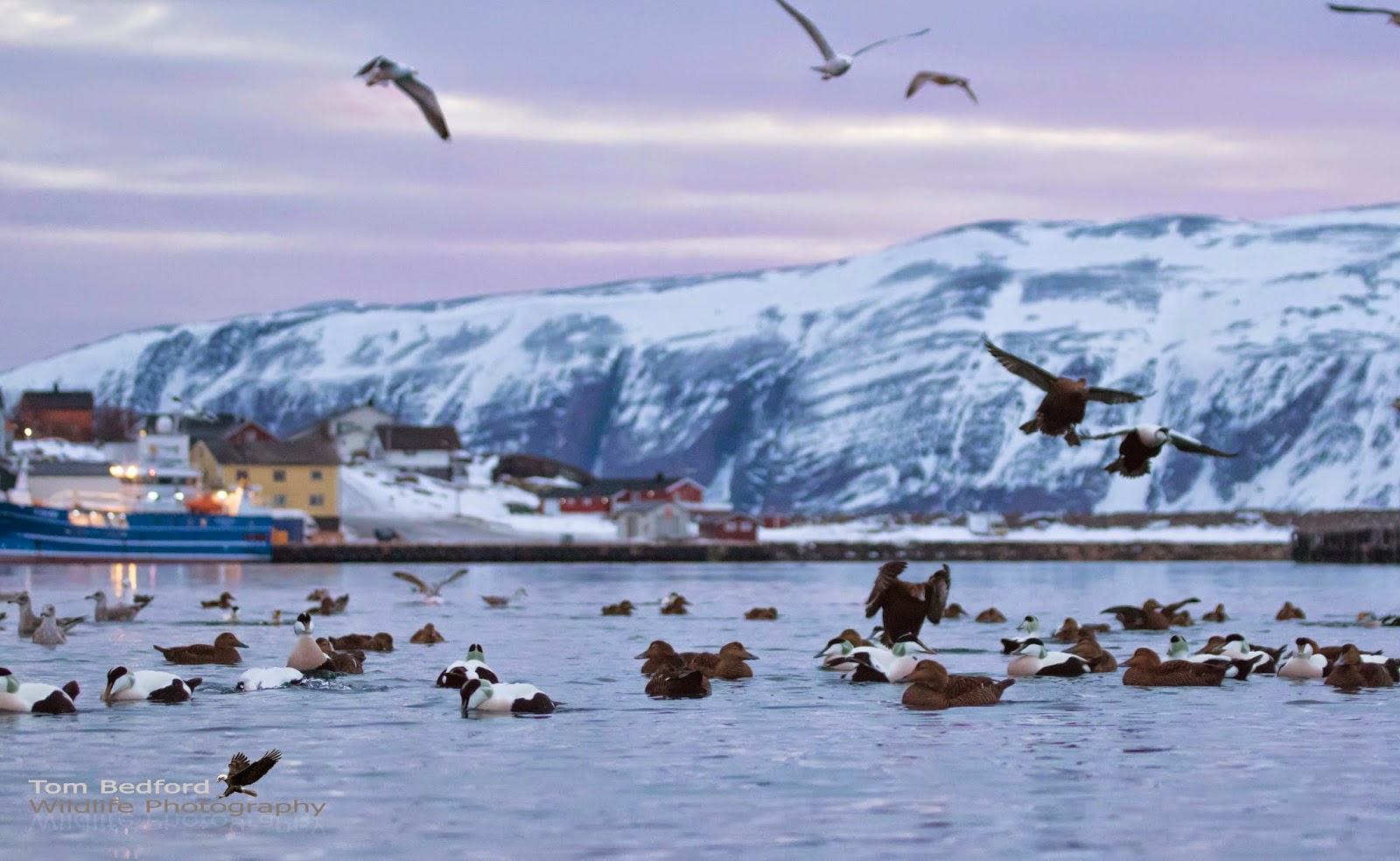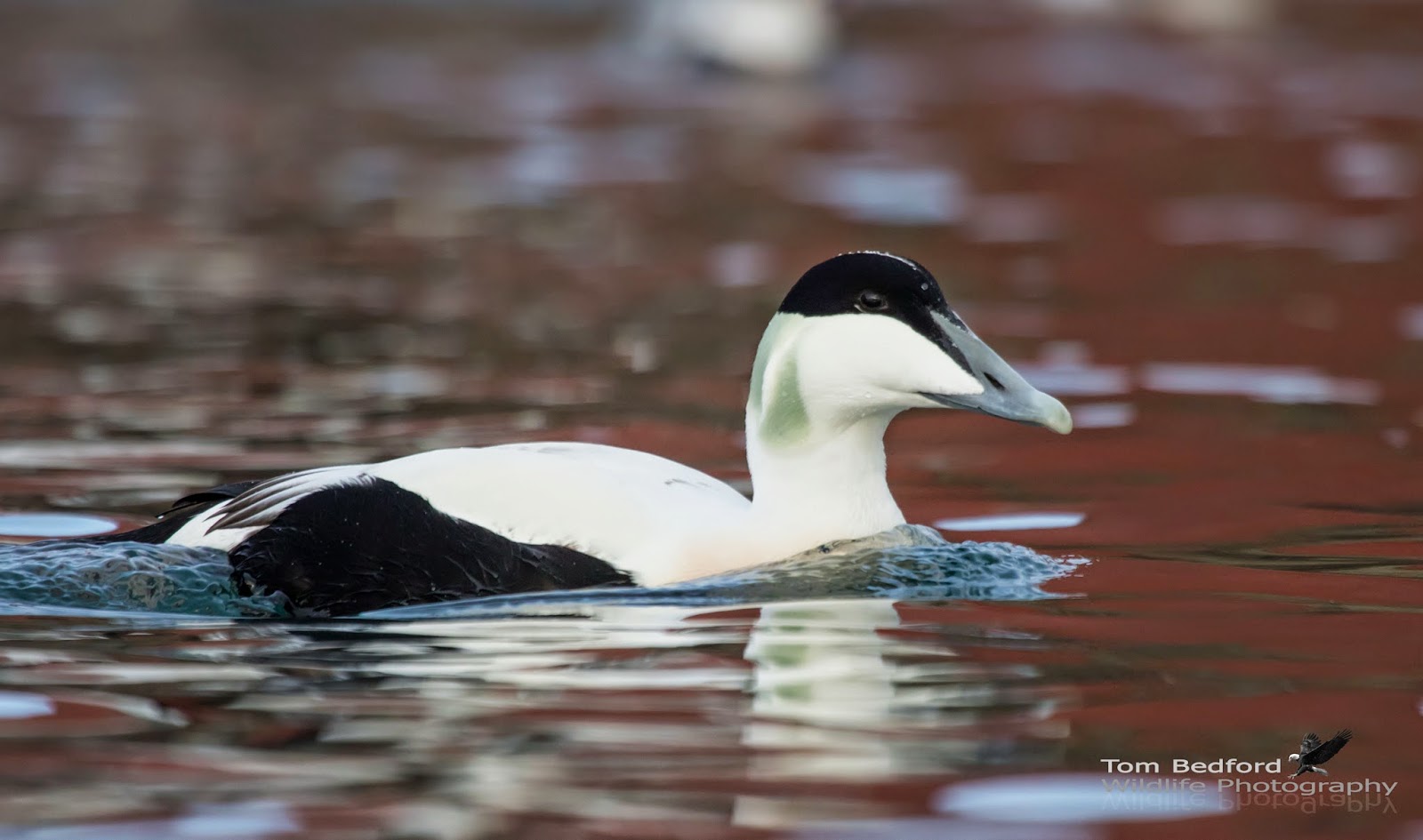My previous experience of seeing King Eider was limited and distant. A first winter male in, but mostly behind the waves, off Holkham, Norfolk some ten years ago. Then there was a small flock of males off Longyearbayen in Svalbard in 2011. They were perhaps 2km away, just pale blobs of colour, virtually unidentifiable even in the 'scope. Today was going to be the day that all changed, as I was booked in to use Ørjan Hansen's floating Eider hide in Båtsfjord harbour.
The setting: the red building on the right of the photo below is the fish processing plant in Båtsfjord. Fish waste is discarded into the water under the jetty that it stands on. The three species of Eider that winter in the fjord and the adjacent Barents Sea have discovered this easy source of food and come into the harbour to feed. The floating photography hide is the long dark object, moored to the left of the factory. Photographers are brought into the hide at first light and then picked up at lunchtime as feeding activity reduces.
I was picked up at 05:25, I met up with my companions for the day, a friendly Dutch couple and we were in the hide by 06:00, well before sunrise:
The hide takes up to eight people, so having the entire thing to share between three of us made for a relaxed experience. As soon as the boat that had brought us over departed, Eiders began flying in from the fjord. Initially Common Eiders...
.. but soon lines of Queen Eiders began streaming in:
(Yeah, I just noticed the mustard yellow bill and frontal lobes on the male Common Eider in the middle of the picture too. I can't make out any scapular sails, though the angle is unhelpful, so I'm assuming that this is a variant Common Eider rather than a Northern Eider, borealis? If you think differently: tell me!).
These are truly stunning birds:
Many drakes began displaying as soon as they arrived:
The King Eiders were not only completely relaxed by the hide, they were almost inquisitive as to what was going on inside. Many were close enough to touch. It was not difficult to photograph them. The reflections from the fish factory painted the water a lovely red colour. Next year they are repainting the building blue, so expect to see lots of King Eider photographs bathed in deep Mediterranean blue.
To lie in the hide in such close proximity to these fabulous arctic sea duck was a real thrill. Getting close to these species outside of the hide would be impossible. Here some birds almost entered the hide they were so close. Both sexes of King Eider would regularly swim within 2 meters of me, giving incredible, intimate views:
The floating hide is clearly reflected in the eye of this drake King Eider:
♂ Common Eider, or if you are French, Eider á duvet:
♀ Common Eider:
♀ King Eider for comparison:
Sure, there are differences in the feather pattern around the bill in female Common and King Eiders. But the smaller size, more rounded head and darker bill stood out much more for me. Plus the Queen smiles more:
♂ Stellers's Eider: the smallest, rarest and most duck-like of the Eiders present in Båtsfjord harbour:
These birds take on a completely different appearance when viewed head on. The dark spots on their flanks mirror the dark eyes on the pale head, set off by the darkest of green neck collar and throat patch:

The green tuft on the back of the head is an unusual feature:

Below, a ♀ Steller's Eider, just out of arm's reach. There can be no confusing this female Eider with the other two Eider species present. If it looks like a duck, it's a Steller's!
♀ Steller's Eider, with Queen Eider in background.
♂ Long-tailed Ducks provided the soundtrack to the experience, a constant evocative yelping. The males were very smart in winter plumage:
♀ Long-tailed Duck. Cute.
I got lucky with my companions in the photo hide. I shared it with this friendly Dutch couple. We are not obese, despite our appearances in the photo, below. The red survival suits are seriously bulky. Honest. We also shared an aversion to the suggestion that we should spend some time getting some "escape shots" of the eiders in the fjord. These resting eiders are chased by the photo-boat daily at this time of year. Surely this will discourage birds from gathering eventually? We passed one flock of King Eiders, saw them take off, then we asked to head back to Båtsfjord.


1st winter Glaucous Gull, checking out the boat on the way back.
What an experience. Now I can say that I have seen King Eiders. Highly recommended.



































What an amazing trip,superb images,I would love to see King Eiders that close,looks like Bird Paradise to me.
ReplyDeleteJohn.
Thank you, John, for your kind comments. The Eider hide was close to bird paradise for a few hours :-)
DeleteCheers, Tom